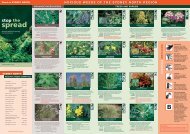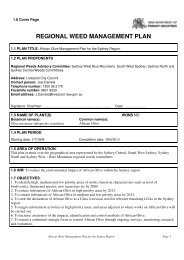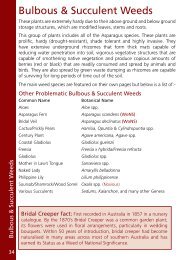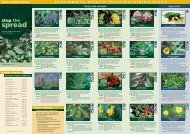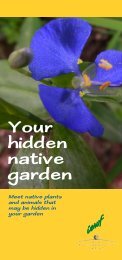“Garden Escapes” education booklet - Sydney Weeds Committees
“Garden Escapes” education booklet - Sydney Weeds Committees
“Garden Escapes” education booklet - Sydney Weeds Committees
You also want an ePaper? Increase the reach of your titles
YUMPU automatically turns print PDFs into web optimized ePapers that Google loves.
Bulbous & Succulent <strong>Weeds</strong><br />
34<br />
Bulbous & Succulent <strong>Weeds</strong><br />
These plants are extremely hardy due to their above ground and below ground<br />
storage structures, which are modifi ed leaves, stems and roots.<br />
This group of plants includes all of the Asparagus species. These plants are<br />
prolifi c, hardy (drought-resistant), shade tolerant and highly invasive. They<br />
have extensive underground rhizomes that form thick mats capable of<br />
reducing water penetration into soil; vigorous vegetative structures that are<br />
capable of smothering native vegetation and produce copious amounts of<br />
berries (red or black) that are readily consumed and spread by animals and<br />
birds. They are also spread by green waste dumping as rhizomes are capable<br />
of surviving for long periods of time out of the soil.<br />
The main weed species are featured in the following pages but below is a list of<br />
Other Problematic Bulbous & Succulent <strong>Weeds</strong><br />
Common Name Botanical Name<br />
Aloes Aloe species<br />
Asparagus Fern Asparagus scandens (WoNS)<br />
Bridal Veil Asparagus declinatus (WoNS)<br />
Cactus/Prickly Pears Harrisia, Opuntia & Cylindropuntia species<br />
Century Plant Agave americana, Agave species<br />
Coastal Gladiolus Gladiolus gueinzii<br />
Freesia Freesia x hybrida/Freesia refracta<br />
Gladiolus Gladiolus species<br />
Mother in Law’s Tongue Sanseviera species<br />
Naked Lady Amaryllis belladonna<br />
Philippine Lily Lilium philippinense<br />
Soursob/Shamrock/Wood Sorrel Oxalis species<br />
Various Succulents Sedums, Kalanchoe, and many other Genera<br />
Bridal Creeper fact: First recorded in Australia in 1857 in a nursery<br />
catalogue. By the 1870’s Bridal Creeper was a common garden plant;<br />
its fl owers were used in fl oral arrangements, particularly in wedding<br />
bouquets. Within 50 years of introduction, bridal creeper had become<br />
naturalised in many areas across most of southern Australia and has<br />
earned its status as a Weed of National Signifi cance.



